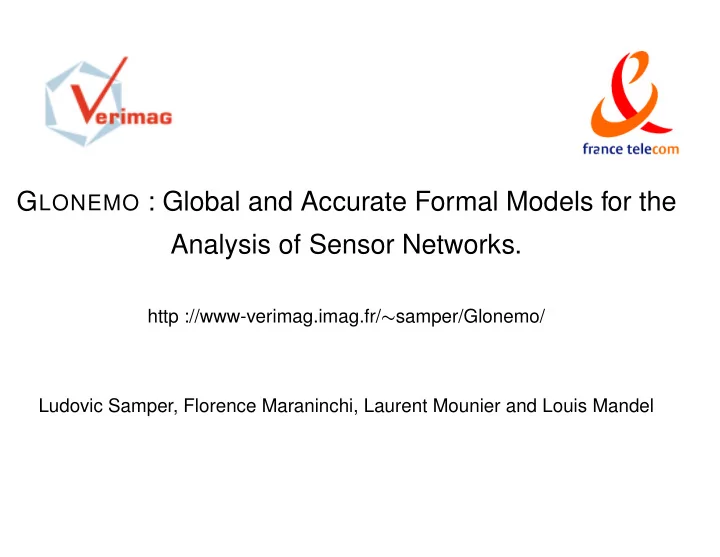

G LONEMO : Global and Accurate Formal Models for the Analysis of Sensor Networks. http ://www-verimag.imag.fr/ ∼ samper/Glonemo/ Ludovic Samper, Florence Maraninchi, Laurent Mounier and Louis Mandel
Context and objectives Sensor networks : – Hundreds or thousands of nodes – No infrastructure – Low rate – Low battery – Applications : detection or monitoring of an event in a distributed manner Objectives : Executable and analyzable models of sensor networks with special emphasis on energy consumption. France Télécom R&D 1
Related Work – Classical network simulators, not dedicated to sensor networks : – NS2 (The Network Simulator), Opnet, Glomosim, ... – NAB (Network in A Box) – Simulators dedicated to sensor networks : – PowerTOSSIM, the consumption is calculated from the number of packets transmitted and the number of instructions executed. – Avrora, written in Java and cycle-accurate – Atemu, executes binary codes – ... – Formal models applied to sensor networks : – Real-Time Maude (Peter C. Ölveczky) – ... – Our work : – A model dedicated to sensor networks – Accurate model of the energy consumption – Model and program using a formally defined language – The aim is to use formal methods France Télécom R&D 2
Approach – A global model – Detailed Hardware – Software : the protocol layers and the application code. – Physical Environment Hardware E Physical N E Sensing CPU Environment R G Y Memory Radio Software MAC Routing Application code France Télécom R&D 3
Modular abstractions : Hardware E N Physical E Environment R G Y Software MAC Routing Application code We want much more than an executable tool : The aim is to use verification tools, runtime-verification tools or formal test. France Télécom R&D 4
Modular abstractions : Hardware E N Physical E Sensing CPU Environment R G Y Memory Radio Software Perfect MAC Layer Routing Application code We want much more than an executable tool : The aim is to use verification tools, runtime-verification tools or formal test. France Télécom R&D 5
Typical Example SINK Wind Cloud – Application : Detection of a radioactive cloud – Routing : Directed diffusion ( C. Intanagowiwat, R. Govindan, D. Estrin, J. Heidemann, F . Silva ) – Medium Access Control : A preamble sampling MAC protocol – Environment : A cloud moving under the influence of the wind. France Télécom R&D 6
Structure of the model Cloud Wind other Air Environment nodes A node Application A node Application Routing MAC Routing MAC Hardware ... Radio CPU Hardware ... Radio CPU Other Observations Observers of Quantitative Prop. Parallel processes with synchronization France Télécom R&D 7
Tools used to program the model – R EACTIVE ML (Louis Mandel, LIP6) : – The ML-language with parallelism – As expressive as the Caml language – Parallelism is a top-level primitive – Belongs to the family of synchronous languages The hardware model, the software and the simulation engine are implemented with R EACTIVE ML – L UCKY (E. Jahier, P . Raymond, VERIMAG) : – A constraint-based language – A language for describing and simulating stochastic reactive systems – Lucky is connected to R EACTIVE ML The cloud and the wind are implemented with L UCKY France Télécom R&D 8
The consumption model of the radio The MAC layer drives this automaton. An "observer" checks the current state to calculate the consumption of the node. 400 µs 145.8 mW Transmit 145.8 mW 144 µs 140.4 mW 100 µs 100 µs Idle Sleep 140.4 mW 140.4 mW 140.4 mW 35.1 mW 332 µs 144 µs 140.4 mW 140.4 mW Receive 140.4 mW Values of the Motorola MC13192 France Télécom R&D 9
Software : ReactiveML code for the application let send_alarm self cloud_pos my_interest = if (present_cloud self cloud_pos) then (if (not self.node_pre_present_cloud) then (response self my_interest; self.node_pre_present_cloud <- true; ) ) else self.node_pre_present_cloud <- false;; France Télécom R&D 10
Environment : The Lucky code for the cloud inputs { Wind_x : float ~init 0.0; Wind_y : float ~init 0.0;} outputs { x_cloud: float ~init 400.0 ~max 1000.0 ~min -100.0; y_cloud: float ~init 300.0 ~max 1000.0 ~min -100.0; } transitions { init -> init ~cond (if Wind_y >= 0.0 then (0.0 <= (y_cloud - pre y_cloud) <= Wind_y) else (Wind_y <= (y_cloud - pre y_cloud) <= 0.0)) and (if Wind_x >= 0.0 then (0.0 <= (x_cloud - pre x_cloud) <= Wind_x) else (Wind_x <= (x_cloud - pre x_cloud) <= 0.0))} France Télécom R&D 11
Environment : The Lucky code for the wind inputs { } outputs { Wind_x : float ~min -5.0 ~max 5.0 ~init 0.0; Wind_y : float ~min -5.0 ~max 5.0 ~init 0.0; } transitions { init -> init ~cond abs (Wind_y - pre Wind_y) < 5.0 and abs (Wind_x - pre Wind_x) < 5.0 } France Télécom R&D 12
Modular abstractions : Use of formal models M1 M2 M’1 M2 1 is more precise than M 1 . M ′ The consumption evaluated with the M ′ 1 model must be smaller than the one evaluated with M 1 ; and this relation must stay true after composition. M ′ M ′ ⇒ 1 � M 2 � M 1 � M 2 1 � M 1 France Télécom R&D 13
Conclusions and perspectives – The formalism is more expressive than other formal models – The formalism enables modular abstractions – Our Model , G LONEMO , includes a realistic model of the environment – G LONEMO can be used to perform simulations. This is useful to have an intuition of the abstractions that could be done. – Indeed, the simulator is quite scalable. – This complete model can already be used to perform automatic testing ; the modular abstractions will allow the use of verification and runtime-verification tools. France Télécom R&D 14
Recommend
More recommend